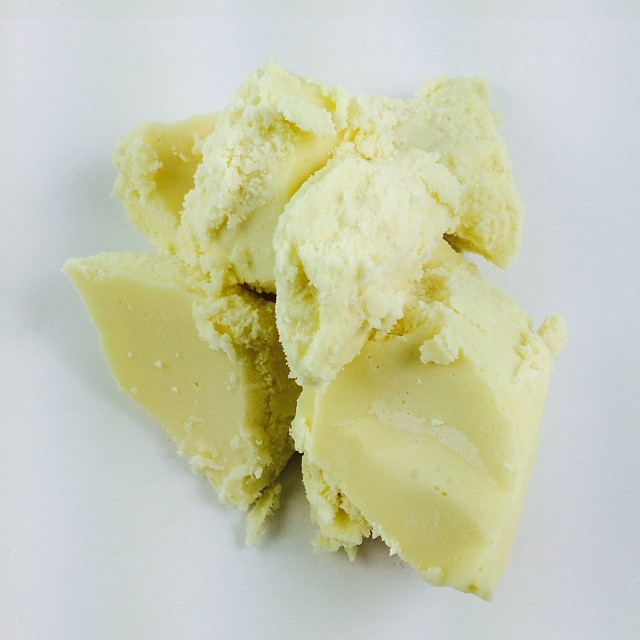Grades of Shea Butter
Our Shea Butter is 100% raw, unrefined and having a thick nutty aroma. Many companies use bleaches, deodorizers, or chemicals to alter the scent and appearance of Shea Butter. Shea Butter naturally has a cream or yellow color, and the distinctive nutty scent. After applying Shea Butter to the skin, the scent will decrease and will disappear in minutes.

Extraction Methods
Most Shea Butter is prepared by hand in small villages across western Africa. Shea Butter processing is historically done by village women, and the method which they use has been passed down from generation to generation. To produce Shea Butter, the fruit is picked and consumed. The nuts are then cracked, grilled and pounded by hand into a paste. They are then boiled in water until the oil rises to the surface of the pot. This oil is then scooped into gourds/calabash, where it is allowed to cool. When the oil has cooled, it thickens into a butter-like consistency. The Shea Butter is then packaged and shipped to us direct from the producers.

Benefits Shea Butter is naturally rich in Vitamins A, E, and F, as well as a number of other vitamins and minerals. Vitamins A and E help to soothe, hydrate, and balance the skin. They also provide skin collagen which assists with wrinkles and other signs of ageing. Vitamin F contains essential fatty acids, and helps protect and revitalize damaged skin and hair. Shea Butter is an intense moisturizer for dry skin, and is a wonderful product for revitalizing dull or dry skin on the body or scalp. It promotes skin renewal, increases the circulation, and accelerates wound healing. It is also beneficial for the treatment of many different conditions, such as:
- Dry skin - Stretch marks
- Itchy skin, skin rashes, Eczema, and Dermatitis - Sunburn
- Small skin wounds - Damaged skin
- Rough skin (such as on feet) - Insect bites
- Muscle aches, fatigue, and tension - Wrinkles and signs of ageing
- Chapped skin from cold weather - Dry or over processed hair
- Diaper rash - Skin allergies
- Frost bite
In addition, Shea Butter offers a low level of UV protection (approximately SPF-6), and may be incorporated into natural sunscreen recipes. Because of its soothing nature, anti-inflammatory and rejuvenating effects, it is a perfect ingredient to incorporate into your body-care recipes and skin care regime. It is also wonderful to use in the summer as a moisturizer before and after sun exposure to reduce possibility of the skin peeling or becoming dried out.
Using Shea Butter
At room temperature, Shea Butter is semi-soft and solid. However, the melting point of Shea Butter is 89-95 degrees and it will melt readily once applied to the skin. Since Shea Butter absorbs so quickly, it immediately relieves dry and irritated skin. There are many different uses for Shea Butter, below are some of the ways in which Shea Butter may be used.
May be easily incorporated into, Lotions, Creams, and Body Butters: Add a spoonful to your bath water for a luxurious and healing experience. Especially helpful for those with dry or itchy skin, or sore muscles. Try adding Lavender or Chamomile essential oil as well, or an herbal infusion made from soothing herbs. In massage, Shea Butter is beneficial for overexerted muscles or for dry skin. If the odor is too strong, warm the butter slightly over a double boiler, and add essential oils. In soaps, Shea Butter has a conditioning effect. Try incorporating Shea Butter into your handmade soap recipes. Massaged into the scalp for dry scalp symptoms and to stimulate hair growth. Use during pregnancy to keep the skin supple, and to prevent stretch marks. It may also be used after giving birth to reduce stretch marks.
No comments:
Post a Comment